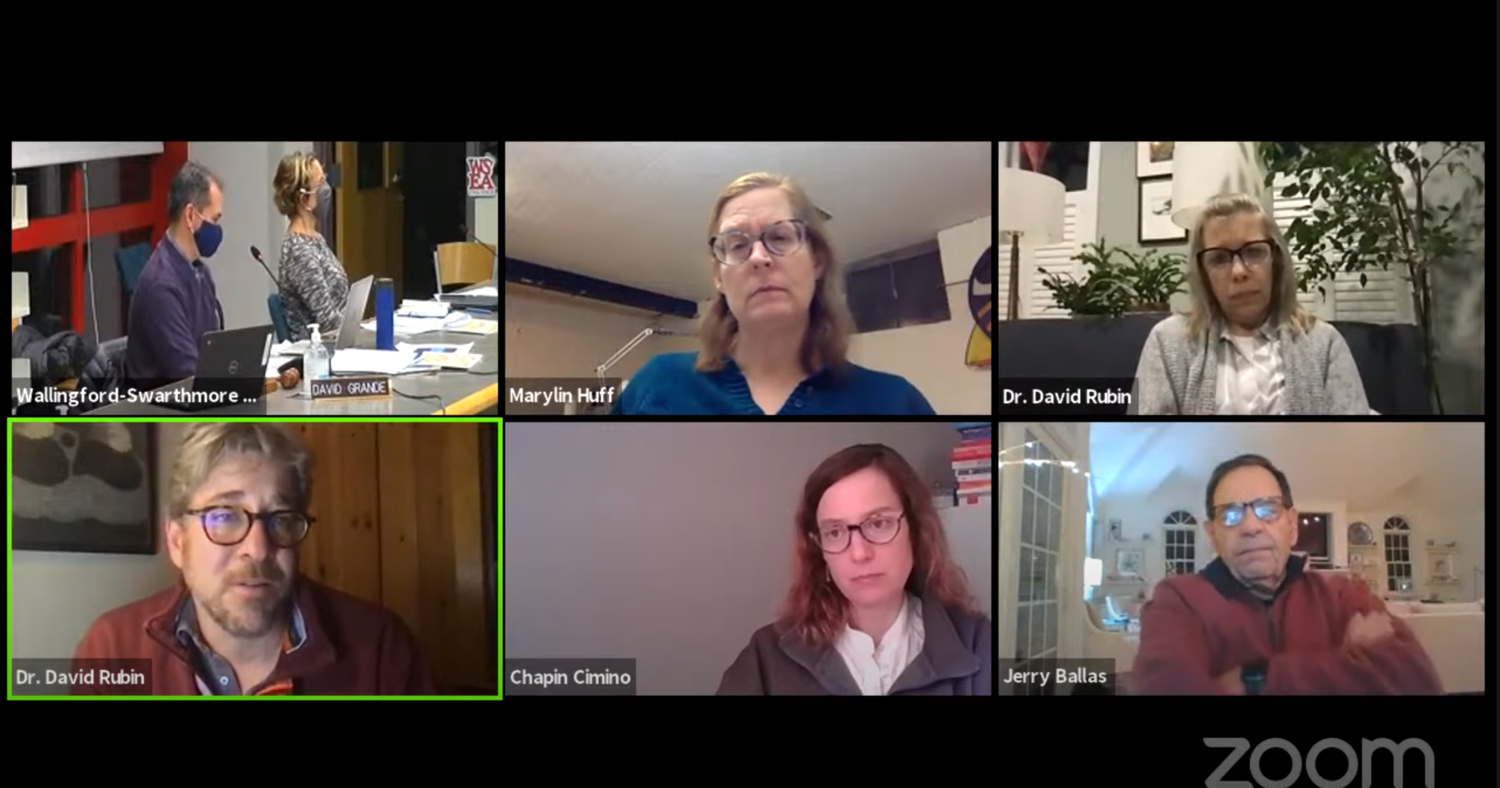Board Weighs Full Reopening of Elementary Schools at Marathon Meeting
“No decision has been made yet.”
That was Wallingford-Swarthmore School Board president David Grande’s message for the community at the board’s 5½-hour meeting Monday night. The meeting considered whether the district will reopen elementary schools for near-full-time instruction next month.
The reopening decision has racked the community, with vehement and sometimes angry words exchanged at school board meetings, on Facebook, and on Nextdoor. (See article below.) Petitions have circulated, and the school board’s public comment line has been flooded with calls. Over 60 calls were transcribed and read aloud at Monday’s meeting, which concluded well after midnight. Over 1,700 people have watched the meeting on YouTube.
Grande announced that families are receiving a survey asking whether they would send their students to in-person school under the transition plan, or opt for the all-virtual Online Academy. The board is asking parents to make a commitment now because “it’s very difficult to make this decision without understanding the implications of implementation,” Grande said.
The board will vote on reopening after the survey results and accompanying parent comments are reviewed.
David Rubin, highlighted in lower left of the Zoom call.
CHOP PolicyLab Perspective
David Rubin, director of PolicyLab at the Children’s Hospital of Philadelphia, and PolicyLab’s Susan Coffin, a pediatric infectious disease specialist and epidemiologist, attended the meeting to review the latest data about COVID in schools and offer advice.
Rubin said that area schools’ caution about reopening in the fall may have helped them avoid the extremely high case counts that bedeviled parts of the Midwest and led to school closures there. But he also noted that school-safety plans developed by PolicyLab and others “have worked extremely well.” COVID transmission in schools has been low, he reported, with most cases traceable to out-of-school activities.
“We’ve gone through a difficult winter,” Rubin remarked. With warmer weather approaching, he suggested, “it’s an appropriate time to start planning and taking advantage of the window you may have.” But he also advised moving cautiously, saying, “Walk before you run.”
Coffin described new rapid tests, developed by PolicyLab, that give results in 15 minutes. The district’s reopening plan includes weekly tests for staff members and for students with conditions that prevent them from wearing masks, according to director of student services Gina Ross. In the future, district athletes might also be regularly tested. Any student or staff member who develops symptoms during the school day will be tested. Ross reported that staff members are currently learning how to use the tests, which are expected to be available in about three weeks.
Coffin explained that onsite rapid testing sends asymptomatic COVID patients home and provides ongoing information about who is sick. This offers additional safety, allowing people “to feel happier and more confident in spending time at school.”
Grande noted that bringing students back into schools full-time means reducing 6-foot distancing requirements. He asked whether the additional protection testing provides might compensate for reduced social distance.
Rubin replied that, with cases going down and rapid testing added as an additional mitigation strategy, he feels optimistic that “resumption of a normal school day is possible.” He also urged patience, suggesting that reopening works best in warmer weather. “For many districts, it’s a decision of timing,” he said. “Is it mid-March, or is it April?”
Rubin reported that there is little data on how much protection masking-wearing offers when people move within 6 feet of each other. “That remains a topic of debate,” he said. If a school decides to “walk through that threshold,” Rubin added, boosting other mitigation measures like testing is important.
Coffin cautioned that masks are not always good quality or worn correctly. Improved mask-wearing is a more effective mitigation strategy, she said, than either extensive surface cleaning or improving ventilation.
The Plan
Denise Citarelli Jones, director of education, presented a draft plan for a potential return to nearly full-time in-person school. She also indicated a timeline for getting there. The plan calls for four-and-half days of in-person school, with one half day of asynchronous learning. This half day would enable teachers to serve on committees, engage in professional development, and attend individualized education plan meetings, among other tasks. Citarelli Jones noted that the plan also would enable in-person PSSA exams if the commonwealth decides to hold them this year. PSSAs were canceled last year because of the pandemic.
Under the transition plan, students would maintain 3 feet of distance at all times. In classrooms, that means that the middle of one desk would be 3 feet from the middle of the next desk. During lunch, or any other time students were unmasked, the distance would be 6 feet. 6 feet would probably still be the standard distance mandated between adults and students, though Citarelli Jones noted that it’s not always possible for teachers to stay that far from young students.
The plan would provide additional PPE for students and staff, establish new protocols to streamline bus and car drop off and pick up, and stagger schedules to keep hallways and stairwells uncrowded. Three-sided clear plastic dividers would be placed on every desk.
The plan’s requirement that students bring charged electronic devices to school every day drew criticism from board member Jennifer Lentz. Nora Wheeler, director of instructional technology, advocated for the requirement to provide a way for students to collaborate without sitting close together. Wheeler said she expected devices would be used in a limited, strategic way.
Citarelli Jones announced that the district would try to keep Online Academy students who remain in that modality with their current teachers. Students moving from in-person to online, or online to in-person, would probably change teachers, she said. Some teachers may be reassigned, and hiring some new teachers may be necessary.
The Timeline
Citarelli Jones outlined what she called “the most aggressive timeline” for implementation, should the transition plan be adopted.
February 9-15: Binding survey of families asking whether they would opt for in-school or online instruction.
February 16-19: Analysis of survey.
February 22: Board vote on transition plan.
If the board approves the transition plan, March 18 would be the first possible day it could go into effect, Citarelli Jones said. Communication with parents, development of new procedures, rearrangement of rooms, and new hiring will take time, she explained.
Citarelli Jones said the district will maintain an updated FAQ about the plan on its website. “As we make decisions, that’s where you’ll see them.”
The next board meeting will be Monday, February 22, at 7 p.m., in the Strath Haven Middle School library, 200 S. Providence Road, Wallingford. If you prefer to watch at home, go to WSSD’s YouTube channel.




